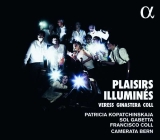 Plaisirs Illuminés: Bela Bartok: Duo Pizzicato für 2 Violinen; Francisco Coll: Les Plaisirs Illuminés, Doppelkonzert für Violine, Cello und Kammerorchester, + Lalula Lied; Alberto Ginastera: Konzert für Streicher; György Kurtag: Jelek VI aus Games, Signs and Messages; György Ligeti: Balada si joc für 2 Violinen; Sandor Veress: Musica concertante für 12 Streicher; Camerata’s birds (Improvisation); Patricia Kopatchinskaja, Violine, Sol Gabetta, Cello, Camerata Bern, Francisco Coll; 1 CD Alpha 580; Aufnahme 06/2019, Veröffentlichung 08/01/2021 (74'26) – Rezension von Uwe Krusch
Plaisirs Illuminés: Bela Bartok: Duo Pizzicato für 2 Violinen; Francisco Coll: Les Plaisirs Illuminés, Doppelkonzert für Violine, Cello und Kammerorchester, + Lalula Lied; Alberto Ginastera: Konzert für Streicher; György Kurtag: Jelek VI aus Games, Signs and Messages; György Ligeti: Balada si joc für 2 Violinen; Sandor Veress: Musica concertante für 12 Streicher; Camerata’s birds (Improvisation); Patricia Kopatchinskaja, Violine, Sol Gabetta, Cello, Camerata Bern, Francisco Coll; 1 CD Alpha 580; Aufnahme 06/2019, Veröffentlichung 08/01/2021 (74'26) – Rezension von Uwe Krusch

In dieser Aufnahme werden neben einer Improvisation des Orchesters sieben Kompositionen von sechs Komponisten vorgestellt. Dabei verbinden diese zum Teil Lehrer-Schüler-Beziehungen. Aber alle ziehen Ideen auch aus der Volksmusik. Bei Bartok, Kurtag, Ligeti und auch Veress war das geradezu prägend. Aber auch Ginastera wurde neben europäischen Einflüssen durch die Musik seiner lateinamerikanischen Heimat inspiriert. Coll wiederum hat bei den Vorgenannten ebenso Anregungen bekommen wie im dritten Satz seines Doppelkonzertes beim Flamenco.
Daneben sind die Musica Concertante von Veress und das Doppelkonzert von Coll durch ihre höchstfordernden Konstruktionen so anspruchsvoll, dass bei Coll sogar der Komponist das ansonsten ohne Dirigenten auftretende Ensemble leitet.
Doch im Endeffekt sind diese Umstände nur zu meisternde Herausforderungen für dieses hochengagiert spielende Orchester. Sicherlich sind die meisten Orchester darauf aus, Musik bestmöglich zu spielen. Doch bei manchen geht dieser Einsatz noch darüber hinaus, sie gehen sozusagen die Extrameile. Und dazu gehört das Berner Kammerorchester. Egal ob Vierteltöne oder gegeneinander verschobene Rhythmen, sie erobern jedes Werk mit Können und Einsatz, wozu auch die musikalisch differenzierte Gestaltung gehört. Die solistisch Mitwirkenden aus dem Orchester sind es gewohnt, nicht nur im Tutti zu agieren, so dass sie sich mit Leichtigkeit an Kopatchinskajas Seite stellen.
Für Patricia Kopatchinskaja hat Franciso Coll das Lalula-Lied komponiert. Auch hier ist, wie so oft, neben der Stimme ihrer Geige auch ihre Singstimme zu hören. Mit packendem Zugriff und nimmermüder Neugier widmet sie sich kleinformatigen Elementen wie Kurtags Jelek VI und dem Pizzicato-Duo von Bartok ebenso sorgfältig wie dem großformatigen Doppelkonzert von Coll. An ihrer Seite spielt für dieses Werk Sol Gabetta. Aus einer Duofassung für sie beide entstanden, surrealistischen Gedankengut aus dem gleichnamigen Gemälde von Dali auf die Musik übertragend, erweitert es das Duo in verschiedenen Ebenen. Die Solistinnen gestalten die Komposition zusammen mit dem Orchester über durchaus auch schön klingende Töne im Wiegenlied bis hin zu sich umschmeichelnden Solostimmen im letzten Satz. So werden die titelgebenden Genüsse mit subtiler Beleuchtung ausgekostet.
In this recording, alongside an improvisation by the orchestra, seven compositions by six composers are presented. Some of those are connected by teacher-pupil relationships. But all of them also draw ideas from folk music. In the case of Bartok, Kurtag, Ligeti and also Veress, this was almost formative. But Ginastera, too, was inspired not only by European influences but also by the music of his Latin American homeland. Coll, in turn, was inspired by the aforementioned as well as by flamenco in the third movement of his Double Concerto.
In addition, the Musica Concertante by Veress and the Double Concerto by Coll are so demanding due to their highly challenging constructions that in Coll’s case even the composer has to lead the ensemble, which otherwise performs without a conductor.
But in the end, these challenges are well mastered by this highly committed orchestra. Certainly, most orchestras are out to play music in the best possible way. But for some, this commitment goes beyond that, they go the extra mile, so to speak. And the Bern Chamber Orchestra is one of them. Whether it’s quarter tones or rhythms shifted against each other, they conquer every work with skill and commitment, which also includes musically differentiated shaping. The soloists from the orchestra are accustomed to performing in more than just the tutti, so that they stand by Kopatchinskaja’s side with ease.
Franciso Coll composed the Lalula song for Patricia Kopatchinskaja. Here, too, as so often, her singing voice can be heard alongside the voice of her violin. With gripping access and tireless curiosity, she devotes herself to small-format elements such as Kurtag’s Jelek VI and Bartok’s Pizzicato Duo just as carefully as to Coll’s large-format Double Concerto, in which Sol Gabetta is her partner. Created from a duo version for the two of them, transferring surrealist ideas from Dali’s painting of the same name to the music, the works expands the duo on various levels. The soloists shape the composition together with the orchestra, from beautiful-sounding notes in the lullaby to caressing solo voices in the last movement. In this way, the pleasures mentioned in the CD’s title are valued with subtle illumination.






















